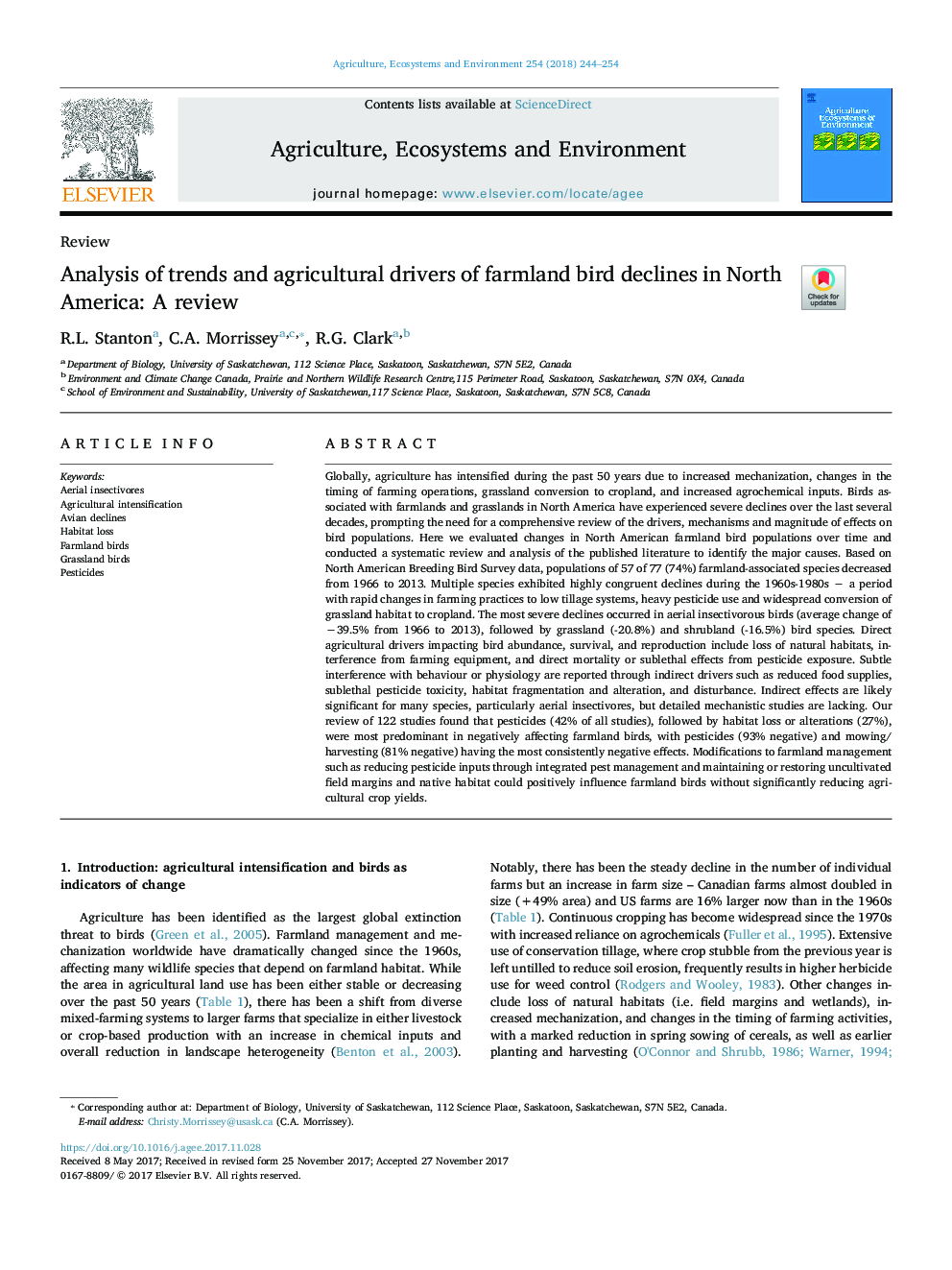| کد مقاله | کد نشریه | سال انتشار | مقاله انگلیسی | نسخه تمام متن |
|---|---|---|---|---|
| 8487220 | 1551998 | 2018 | 11 صفحه PDF | دانلود رایگان |
عنوان انگلیسی مقاله ISI
Analysis of trends and agricultural drivers of farmland bird declines in North America: A review
ترجمه فارسی عنوان
تجزیه و تحلیل روند و رانندگان کشاورزی از پرندگان کشاورزی زمین در آمریکای شمالی کاهش یافته است: بررسی
دانلود مقاله + سفارش ترجمه
دانلود مقاله ISI انگلیسی
رایگان برای ایرانیان
کلمات کلیدی
حشره کش هوا، تشدید کشاورزی، پرندگان از بین می روند، نابودی زیستگاه، پرندگان کشاورزی پرندگان علفزار، آفت کش ها،
موضوعات مرتبط
علوم زیستی و بیوفناوری
علوم کشاورزی و بیولوژیک
علوم زراعت و اصلاح نباتات
چکیده انگلیسی
Globally, agriculture has intensified during the past 50 years due to increased mechanization, changes in the timing of farming operations, grassland conversion to cropland, and increased agrochemical inputs. Birds associated with farmlands and grasslands in North America have experienced severe declines over the last several decades, prompting the need for a comprehensive review of the drivers, mechanisms and magnitude of effects on bird populations. Here we evaluated changes in North American farmland bird populations over time and conducted a systematic review and analysis of the published literature to identify the major causes. Based on North American Breeding Bird Survey data, populations of 57 of 77 (74%) farmland-associated species decreased from 1966 to 2013. Multiple species exhibited highly congruent declines during the 1960s-1980s â a period with rapid changes in farming practices to low tillage systems, heavy pesticide use and widespread conversion of grassland habitat to cropland. The most severe declines occurred in aerial insectivorous birds (average change of â39.5% from 1966 to 2013), followed by grassland (â20.8%) and shrubland (â16.5%) bird species. Direct agricultural drivers impacting bird abundance, survival, and reproduction include loss of natural habitats, interference from farming equipment, and direct mortality or sublethal effects from pesticide exposure. Subtle interference with behaviour or physiology are reported through indirect drivers such as reduced food supplies, sublethal pesticide toxicity, habitat fragmentation and alteration, and disturbance. Indirect effects are likely significant for many species, particularly aerial insectivores, but detailed mechanistic studies are lacking. Our review of 122 studies found that pesticides (42% of all studies), followed by habitat loss or alterations (27%), were most predominant in negatively affecting farmland birds, with pesticides (93% negative) and mowing/harvesting (81% negative) having the most consistently negative effects. Modifications to farmland management such as reducing pesticide inputs through integrated pest management and maintaining or restoring uncultivated field margins and native habitat could positively influence farmland birds without significantly reducing agricultural crop yields.
ناشر
Database: Elsevier - ScienceDirect (ساینس دایرکت)
Journal: Agriculture, Ecosystems & Environment - Volume 254, 15 February 2018, Pages 244-254
Journal: Agriculture, Ecosystems & Environment - Volume 254, 15 February 2018, Pages 244-254
نویسندگان
R.L. Stanton, C.A. Morrissey, R.G. Clark,
